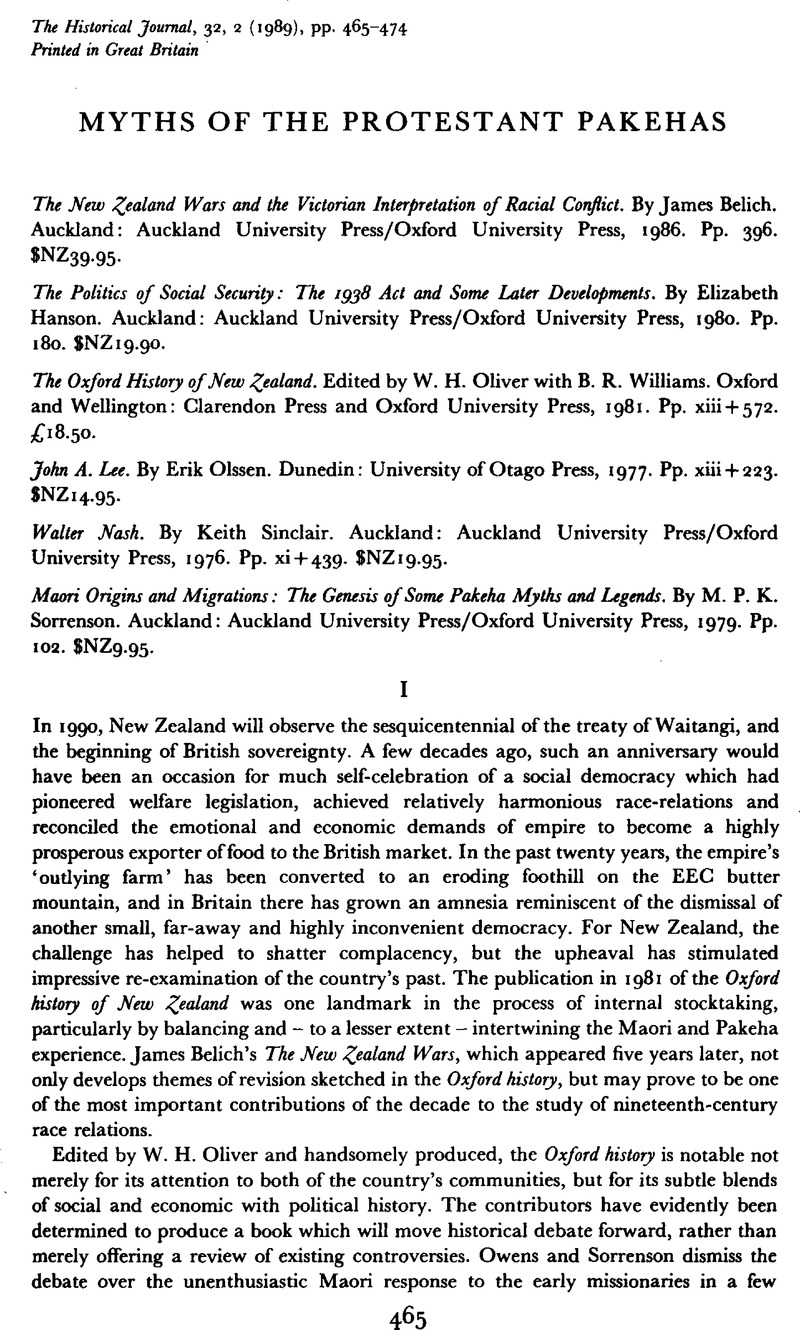No CrossRef data available.
Article contents
Myths of the Protestant Pakehas
Published online by Cambridge University Press: 11 February 2009
Abstract

- Type
- Review Articles
- Information
- Copyright
- Copyright © Cambridge University Press 1989
References
1 Oxford history of New Zealand [cited as OHNZ, with contributor in parentheses], pp. 38 (Owens), 171 (Sorrenson).
2 OHNZ, P. 308 (Gibbons).
3 Ibid. p. 81 (Gardner).
4 Ibid. pp. 3–27 (Davidson).
5 Ibid. p. 435 (Oliver).
6 Pickens, K. A., ‘The writing of New Zealand History: a Kuhnian perspective’, Historical Studies (Melbourne), XVII, 1977, 384–98Google Scholar.
7 OHNZ, P. 29 (Owens).
8 Quoted in OHNZ, P. 103 (Dalziel).
9 Ibid. p. 240 (Brooking). However, the argument for localism is perhaps taken far by Olssen's citation of study showing that ‘between 1875 and 1914, men in Oamaru rarely took as wives any women living more than sixteen miles away’ (ibid. p. 275). Oamaru is hemmed in by the Waitiki River and the Kakanui Range, and most of its hinterland is within a sixteen-mile radius.
10 Ibid. p. 382 (Hawke).
11 Ibid. p. 328 (Gibbons).
12 Davis, R. P., Irish issues in New Zealand politics 1868–1922 (Dunedin, 1974), p. 205Google Scholar.
13 Quoted in OHNZ, P. 127 (Graham).
14 Quoted in Olssen, , John A. Lee, p. 212Google Scholar.
15 Quoted in ibid. p. 141.
16 OHNZ, PP. 263–4 (Olssen).
17 Hanson, , Politics of social security, p. 22Google Scholar.
18 Ibid. p. 96.
19 Olssen, , John A. Lee, p. 44Google Scholar.
20 OHNZ, P. 219 (Richardson).
21 Sinclair, , Walter Nash, pp. 17, 320Google Scholar.
22 Quoted in Hanson, , Politics of social security, pp. 43–4Google Scholar.
23 According to Sinclair, Social Credit ‘has been the country's Aladdin's Lamp, golden-egged goose, state lottery, and “cargo cult”.’ But Lee regarded the theories of Major Douglas as ‘the corridor’ by which middle class voters shifted to Labour in the 1930s, and when Nash became finance minister, Lee indicated that his own monetary theories were not dissimilar: ‘we shall make Walter print and print and print to the limit of commonsense.’ (Sinclair, , Walter Nash, pp. 106, 116, 123Google Scholar.) Richardson regards Labour's monetary policies in the 1930s as ‘scarcely distinguishable from Douglas Credit’ (OHNZ, P. 222).
24 Sorrenson, , Maori origins, p. 7Google Scholar.
25 OHNZ PP. 300–1 (King).
26 Sorrenson, , Maori origins, pp. 72–3Google Scholar.
27 Ibid. pp. 44 ff.
28 Ibid. pp. 19–21.
29 Ibid. pp. 75–6.
30 Ibid. pp. 14–15, for Samuel Marsden. Another missionary, Thomas Kendall, traced cannibalism to Old Testament origins. His fascination with Maori ways led to his dismissal. Binney, Judith, The legacy of guilt: a life of Thomas Kendall (Auckland, 1968), p. 83Google Scholar.
31 Sorrenson, , Maori origins, pp. 19–21Google Scholar.
32 Ibid. pp. 21, 29.
33 Ibid. pp. 34–5.
34 Ibid. p. 15, quoting Samuel Marsden.
35 OHNZ, pp. 148–9 (Parsonson).
36 Ibid. p. 284, (King).
37 Ibid. p. 149 (Parsonson).
38 Ibid. p. 161 (Parsonson).
39 Belich, , The New Zealand Wars, pp. 29–70Google Scholar.
40 Ibid. pp. 47–54, 291–8.
41 Ibid. pp. 177–83, 295.
42 Quoted in ibid. p. 69.
43 Ibid. p. 313.
44 Quoted in ibid. p. 180.
45 Ibid. p. 83.
46 Ibid. p. 315.
47 OHNZ, p. 175 (Sorrenson).
48 Belich, , The New Zealand Wars, pp. 76–80Google Scholar.
49 Ibid. p. 102–4.
50 Ibid. p. 302.
51 Ibid. pp. 306.
52 Ibid. p. 304.
53 Ibid. pp. 311–35.
54 Ibid. pp. 39–40. Belich makes a convincing case that the ‘modern pa’ could withstand both bullets and shells, but presumably – to extend the analogy with the Western Front – the huddled defenders should have been vulnerable to hand grenade attack. The British apparendy used hand grenades in the Waikato campaign (ibid. p. 146). During the earlier Northern War, artillerymen had experimented, unsuccessfully, with the manufacture of ‘stench balls’ from empty shell cases as a primitive form of gas attack, ‘the effect of which was expected to deprive the rebels of all animation’. (Quoted in Barthrop, Michael, To face the daring Maoris: soldiers' impressions of the First Maori War 1845–47 (London, 1979), p. 95Google Scholar.
55 For example in accepting the grumblings of a settler newspaper as evidence (Belich, . The New Zealand Wars, p. 101)Google Scholar. Rejecting British claims for Maori losses in one engagement, Belich states: ‘Five Maori sources confirm that only fourteen or fifteen warriors were killed’ (ibid. p. 134). In cultures dominated by oral tradition, repetition is not necessarily confirmation.
56 Ibid. pp. 203–88.
57 Quoted in Sinclair, , Walter Nash, p. 331Google Scholar.
58 Olssen, , John A. Lee, p. 147Google Scholar.
59 Sinclair, , Walter Nash, p. 65Google Scholar.
60 Olssen, , John A. Lee, p. 117Google Scholar.
61 Sinclair, , Walter Nash, p. 339Google Scholar.
62 Ibid. pp. 86, 92.
63 Ibid. p. 167.
64 There are some interesting glimpses of Mrs Nash, ibid. pp. 32, 46, 99.
65 Ibid. p. 56.
66 Quoted in ibid. p. 337.
67 Ibid. p. 320. ‘I object to New Zealand being represented overseas time and time again by individuals who refer to Great Britain as “Home”’, Lee protested in 1932. Quoted in Olssen, , John A. Lee, p. 60Google Scholar.
68 Sinclair, , Walter Nash, p. 52Google Scholar.
69 Ibid. p. 20.
70 Ibid. p. 52.
72 Ibid. pp. 6, 1.
73 Ibid. p. 35, and cf. p. 86.
74 Olssen, , John A. Lee, p. 6Google Scholar.
75 Ibid. p. 148.
76 Quoted in ibid. p. 110.
77 Sinclair, Keith, ‘The Lee-Sutch syndrome: New Zealand Labour party policies and politics’, New Zealand Journal of History, VIII, 2 (1974), 95–117Google Scholar.
78 Quoted in Sinclair, , Walter Nash, p. 158Google Scholar.
79 Quoted in ibid. p. 79.


